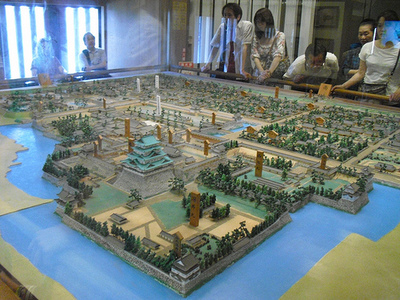Difference between revisions of "Castletowns"
(images) |
|||
| Line 4: | Line 4: | ||
''Jôkamachi'' (lit. "towns below castles") were cities which grew up around [[castles]], especially those which served as a daimyô's "seat," the political center of a ''[[han]]'' (domain) in the [[Edo period]]. | ''Jôkamachi'' (lit. "towns below castles") were cities which grew up around [[castles]], especially those which served as a daimyô's "seat," the political center of a ''[[han]]'' (domain) in the [[Edo period]]. | ||
| − | Castle towns in the 17th century numbered over two hundred | + | Prior to the 1570s, castles were primarily defensive structures, rather than being the permanent political centers and ''daimyô'' residences they would later become. In 1570, the Imperial capital of [[Kyoto]] and the bustling ports of [[Nagasaki]] and [[Sakai]] were among the only cities of any appreciable size in Japan. This changed dramatically, and rapidly, over the course of the [[Azuchi-Momoyama period]] (c. 1573-1598) and the early decades of the 17th century. ''Daimyô'' seats became more permanent, and as ''daimyô'' encouraged merchants into their domains (and, especially, into their castle towns) in order to claim for themselves the economic and cultural benefits of such merchant activity within their borders, many castle towns grew into cities of considerable size, population, and economic power. |
| + | |||
| + | Castle towns in the 17th century numbered over two hundred,<ref>Moriya, Katsuhisa. Ronald Toby (trans.) "Urban Networks and Information Networks." in Chie Nakane and Shinzaburô Ôishi (eds.) ''Tokugawa Japan: The Social and Economic Antecedents of Modern Japan''. University of Tokyo Press, 1990. p104.</ref> and by 1700 Japan was home to some of the largest cities in the world. [[Edo]] at that time is believed to have had a population of roughly one million; [[Osaka]] and [[Kyoto]] were home to roughly 300,000, and the ''daimyô'' seats of [[Nagoya]] and [[Kanazawa]] boasted around 100,000 people each. | ||
==References== | ==References== | ||
Revision as of 21:12, 8 November 2013

- Japanese: 城下町 (joukamachi)
Jôkamachi (lit. "towns below castles") were cities which grew up around castles, especially those which served as a daimyô's "seat," the political center of a han (domain) in the Edo period.
Prior to the 1570s, castles were primarily defensive structures, rather than being the permanent political centers and daimyô residences they would later become. In 1570, the Imperial capital of Kyoto and the bustling ports of Nagasaki and Sakai were among the only cities of any appreciable size in Japan. This changed dramatically, and rapidly, over the course of the Azuchi-Momoyama period (c. 1573-1598) and the early decades of the 17th century. Daimyô seats became more permanent, and as daimyô encouraged merchants into their domains (and, especially, into their castle towns) in order to claim for themselves the economic and cultural benefits of such merchant activity within their borders, many castle towns grew into cities of considerable size, population, and economic power.
Castle towns in the 17th century numbered over two hundred,[1] and by 1700 Japan was home to some of the largest cities in the world. Edo at that time is believed to have had a population of roughly one million; Osaka and Kyoto were home to roughly 300,000, and the daimyô seats of Nagoya and Kanazawa boasted around 100,000 people each.
References
- ↑ Moriya, Katsuhisa. Ronald Toby (trans.) "Urban Networks and Information Networks." in Chie Nakane and Shinzaburô Ôishi (eds.) Tokugawa Japan: The Social and Economic Antecedents of Modern Japan. University of Tokyo Press, 1990. p104.